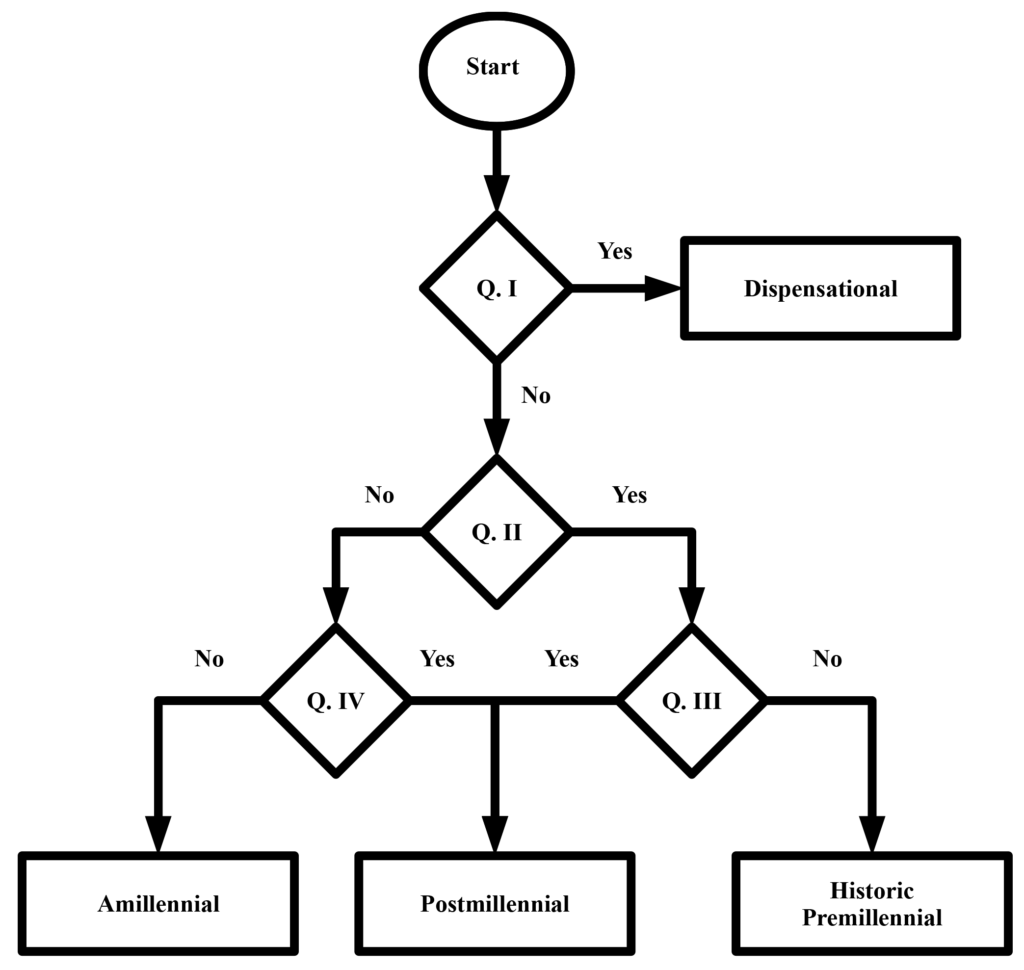
Even though the study of prophecy can become complicated, determining your prophetic view can be reduced to answering four pivotal yes-or-no questions. The outline below will guide you through the process. When you finish, you will have classified yourself as either an amillennialist, a postmillennialist, a historic premillennialist, or a dispensationalist.
We have included a fifth classification, often seen as the one of last resort. It is (somewhat humorously) called “panmillennialism”—the category for those who are not sure how to answer all the questions. Persons in this camp simply trust God to make things “pan out” in the end.
The fact that so many Christians identify themselves as panmillennialists is significant. It indicates answers to the four questions do not come easily. The questions involve fundamental assumptions about the interpretation of the Scriptures. Moving from panmillennialism to a definite view of prophecy requires much study, reflection, and prayer.
The primary goal of this post is to isolate and highlight the key points that define the four common ways of understanding biblical prophecy. Future posts will discuss each of the questions in more depth and provide expanded descriptions of each of the four prophetic views.
So, if you feel comfortable with your answers to these four questions, please follow the outline (or chart) below to determine your prophetic view. The process is relatively straightforward.
The Test In Outline Form
I. What do you believe about Israel after the flesh (1 Corinthians 10:18)? Do you believe the nation of Israel, defined primarily as the fleshly descendants of Abraham, Isaac, and Jacob, continues forever in a unique covenant relationship with God? That is, are Israel after the flesh and the church distinct covenant entities that will exist without mixture throughout the ages?
- If your answer is “no,” please proceed to the next question.
- If your answer is “yes,” you can stop here. You probably hold to the dispensational view of prophecy; it is typically the only view that answers this question in the affirmative.
II. What do you believe about the thousand year reign of Christ as described in Revelation 20:2–7? Does the thousand year reign—the millennium—designate a literal 1000-year period?
- If your answer is “no,” please proceed to question IV.
- If your answer is “yes,” please proceed to the next question.
III. What do you believe about the Second Coming of Christ in relation to the millennium? Will Christ return after his 1000-year reign?
- If your answer is “no,” he will return before the 1000-year reign begins, you probably hold to the historic premillennial view of prophecy.
- If your answer is “yes,” you believe Christ will return after his 1000-year reign, you are probably a postmillennialist.
IV. Are you optimistic regarding the kingdom of God? Specifically, will the kingdom of God be triumphant in culture in history as we move toward the end of the church age?
- If your answer is “yes,” you may consider yourself a postmillennialist. (Some postmillennialists hold to a literal millennium while others believe this 1000-year period symbolizes the entire church age.)
- If your answer is “no,”—in other words, you believe the kingdom’s influence in culture during this age will diminish—you probably fall in the amillennialist camp.
As mentioned earlier, if you cannot answer all of these four questions with certainty, you may consider yourself a panmillennialist.
The Test In Flowchart Form
Here is a flowchart designed for more process-oriented readers. The diamond-shaped symbols represent the decision points (or questions) in the above test. The rectangles represent the terminal points of the process—your prophetic position.
You can know your prophetic view by answering the following four questions and tracking your progress on the chart below.
Q. I. Are Israel after the flesh and the church distinct covenant entities that will exist without mixture throughout the ages?
Q. II. Does the reign of Christ in Revelation 20 refer to a literal 1000 years?
Q. III. Will Christ return after his reign?
Q. IV. Will the kingdom of God exert increasing positive cultural influence in history as the church age continues?

Conclusion
Congratulations, you now know your view of prophecy!
Before concluding this post, we will do well to mention a deficiency in the above test. It is true that the stated criteria are sufficient to identify one of the four main prophetic perspectives. And, by answering these four questions, we can determine which perspective best characterizes our prophetic views.
The problem is that the existing alternatives do not account for all possible combinations of yes/no answers to these questions. For example, the following series of answers does not lead to an available option:
I. “No”—Israel and the church are not eternally distinct covenant entities
II. “No”—the millennial reign of Christ in Revelation 20 is not for a literal 1000-year period
III. “No”—Christ will not return after the millennium of Revelation 20; he will return before it begins
IV. “Yes”—the kingdom of God will overcome all its enemies in history and become the dominant force in the culture of all nations
Our purpose here is not to justify this series of answers, but to notice that the existing systems do not allow for this combination of answers (and possibly others). In order for this combination to be possible, we need another prophetic option made available to us. We also need additional questions in our test to determine if we adhere to that option.
We run the risk of getting ahead of ourselves here. Let us desist at this point and end with a hint that our future studies of prophetic passages may lead us in this direction.
Don’t fret if any of this is unfamiliar to you. As we said, future posts will attempt to explain the details of both the questions and the conclusions in easily digestible increments. They will also examine assumptions inherent in all the existing options.
May we grow in grace and peace together as we explore God’s (prophetic) word.

2 comments
Hello Mike,
This rubric is incomplete. Firstly, Israel can be seen in three categories, not just two: 1. Spiritual Israel (reformed/amil/postmil, Catholic, etc) 2. Spiritual Israel and Jew , or church-jew – Dispensational 3. Spiritual Israel (Remnant by faith) and Two house Israel (Ephraim/Judah)
Hi Dan,
Thanks for the comment, but it has left me somewhat baffled so my comments may not be pertinent to the point you are making. My division of Israel into two categories is based on my reading of Paul. He speaks (1) of Israel after the flesh (1 Cor 10:18) and (2) of Jews who are so inwardly, possessing circumcision of the heart (Rom 2:28–29). I know of no other categories he uses to describe Israel but would be open to you enlightening me on this matter.
Yours for the kingdom of God,
Mike